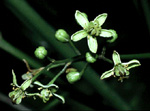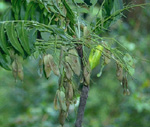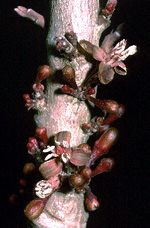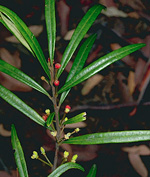 |
This pantropical family occurs in northern and eastern Australian rainforests, from the Top End of the Northern Territory and Cape York to northern coastal New South Wales (although Ailanthus altissima, widely planted and sometimes naturalised, is more widespread).
Characteristic features of the family Simaroubaceae in Australia include: - trees or shrubs with alternate, simple, pinnate or trifoliolate leaves
- flowers small, bisexual or unisexual, regular, white, cream or yellow, with 4 or 5 free or united sepals and petals and the same number or twice as many stamens
- ovary superior, of free or united carpels each with a single ovule, developing into a dry, winged fruit (a samara) or into a drupe
Description
Evergreen or deciduous trees or shrubs. Stems unarmed, or with thorns or spines arising from the leaf axils. Internal secretions not obvious. Plants glabrous, or with simple, non-glandular, unicellular hairs. Leaves alternate and spiral, petiolate. Stipules absent, or present and distinct and free from the petiole, green and leafy, or spine-like, falling off early or persistent; stipellae absent. Lamina simple, or once compound, ternate or imparipinnate, symmetric, lanceolate, ovate, elliptic, oblanceolate, obovate or oblong; base cuneate, rounded, cordate or rarely attentuate; margins serrate, ±flat; venation pinnate, with the midrib conspicuous, and the tertiary venation reticulate or not; surfaces punctate or not; herbaceous; distinctive odour absent or foetid. Domatia absent or consisting of hair tufts in the vein angles. Male and female flowers occurring on the same plant or on separate plants, or with all the flowers bisexual. Inflorescences terminal or axillary, consisting of racemes, panicles, thyrses, umbels or dichasial cymes. Bracts and bracteoles absent. Pollination by insects. Flowers stalked. Floral disc absent; nectaries absent or present on the disc. Perianth regular, of 2 dissimilar whorls. Calyx segments fused, with 4–5 (–6) lobes, imbricate or valvate in bud; calyx bell-shaped, herbaceous. Corolla segments free, with 4–5 (–6) petals, alternating with the calyx lobes, imbricate in bud, white, yellow, red, pink, magenta, purple or green, without contrasting markings, membranous; claws absent; lobes ±entire. Fertile stamens 4, 8 or 10, both opposite to and alternating with the calyx lobes, free of the corolla, free of the ovary and style, distinct from each other, all ±equal. Staminodes present or absent. Anthers dorsifixed or basifixed, not versatile, opening sideways or inwards by longitudinal slits, 2-celled. Ovary superior and sessile. Carpels 2–5, free, fused, or free but with styles or stigmas fused; ovary with (2–) 4–5 locules. Style terminal, single and unbranched, or branched above, or from the base. Ovules 1 per locule, stalked; placentation apical. Fruit often schizocarpic, separating into dry or fleshy indehiscent mericarps, or a samara, or a capsule, or rarely a berry, or a drupe; the perianth on the maturing fruit deciduous. Disseminule macro-surface featureless, winged or costate or with straight hairs; micro-surface ±smooth, yellow, orange, red, brown or black, glossy or dull. Seeds 1 per fruit. Aril absent. Cotyledons 2. Embryo straight or curved.
(Note: this description has been generated from the coded data compiled for the key. Any errors in the key data will be reflected in the descriptions.)
A treatment of the family Simaroubaceae has been published in:
Flora of Australia 25: 188-196.
Australian genera of Simaroubaceae (as recognised for the Flora of Australia)
† = some species native, others introduced
†Ailanthus
Brucea
Harrisonia
Quassia

|
  |

Ailanthus integrifolia (flowers)
Photo: G.Sankowski © Zodiac Publications

Ailanthus triphysa (fruits)
Photo: H.Nicholson © H. & N. Nicholson

Quassia sp. (flowers)
Photo: G.Sankowski © Zodiac Publications

Quassia sp. (flowers)
Photo: M.Fagg © M.Fagg
|
 |
|